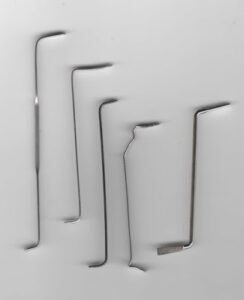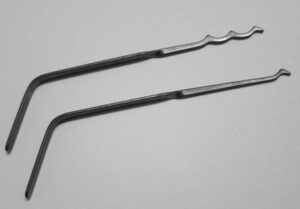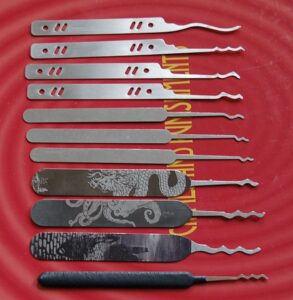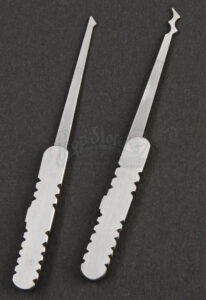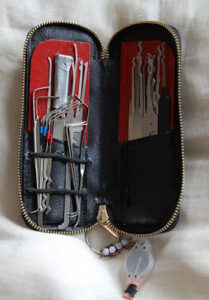One of my reasons for writing this post is that I came across a statement that a certain army was currently issuing several dozen different designs of equipment pouch.
I see pouches for survival tins offered, which misses the point of a survival tin!
One even sees belt pouches for KFS!
This got me thinking about what configurations would be most useful. Some of us do not have an unlimited budget or supply system, after all!
It would be very nice to have pouches designed based on the golden ratio, such as in the proportions 1: 1.618: 2.618. Such gives a litre pouch of about 6 x 10 x 16 cm and a two litre of 7.8 x 12.6 x 20.3 cm.
Attractive though these are, we must also consider more practical considerations such as the dimensions of the already existing items that such pouches will be required to carry.
Medium Utility Pouch Size One
To begin with, let us consider a medium-sized utility pouch with internal dimensions of approximately a litre volume.
This could serve as a water-bottle carrier for typical military designs such as the British 1-litre ’58 pattern and the US 1-quart M-1961.
There should also be room for associated items such as canteen-cups and stoves, so size may be something around 9 x 14 x 22cm.
Personally, I think a two-litre bladder with a drinking tube is more practical, but designing the medium utility pouch to take a water-bottle also gives us a convenient size for many other items.
If you don’t carry a water-bottle, the pouch can still carry a cup and stove, zip ties, pliers, cordage, flashlight and a useful collection of other items.
Personally, I think a cup and stove are pack items rather than something that should be weighing down your belt. A size-one pouch containing these could be mounted on the outside of a pack for easy access.
It can be used to carry several magazines, bagged stripper-clips or several grenades.
The pouch itself would be fairly basic. If a draw-cord neck is desired, a suitable liner is added. Likewise, inserts can configure the interior to specialist roles.
There will be provision to mount smaller pouches on the outside should external pockets be desired
Small Utility/Frag Pouch
There would also be a small utility pouch, perhaps of about 10 x 12 cm.
This item is obviously inspired by the M1967 compass/field dressing pouch, and like this item it can exploit mounting positions high on the body.
It will also be convenient for mounting on the sides of a chest rig where larger pouches might be awkward.
The proposed item will not use the popper fastening that the M1967 does, since these are fiddly if a pouch is partially filled or contains soft contents.
For some contents it may be convenient to be able to mount the pouch with the opening downwards or to the side.
As well as compasses and first field dressings (FFD) such a pouch can hold various other items and would serve as a pouch for frag-grenades. This latter requirement may require a change in proportions.
There may be a case for sizing this pouch to carry mobile phone-shaped items.
Small utility pouches would be designed so they can be mounted on larger pouches. When used for FFD the soldier's blood group should be clearly marked on the outside and a TCCC casualty card or equivalent carried inside
Medium Utility Pouch Size Two
The medium utility pouch will be complemented by a larger version of approximately twice the capacity.
We will call this the “medium size 2” and the previously described variant the “medium size 1”.
The size 2 utility pouch would serve a number of functions and be designed so that it can be worn on the belt or be carried by shoulder strap.
One of its roles is to carry a 2-litre hydration bladder fitted with a drinking tube. This allows the wearer to easily access a source of drinking water independent of any backpack.
Another role for this pouch is to hold an Combat Injury-Immediate First Aid Kit (CI-IFAK). This pouch would contain an insert roll holding a vacuum-packed major trauma kit and a pair of combat tourniquets.
Two such pouches at the back of a soldier’s belt resembles a more compact version of the British army kidney pouches, but their contents are more useful and combat relevant
The size 2 utility pouch was inspired by the Canadian utility pouch that was found to be useful for carrying a (C9) 200rd SAW drum. Alternately, a 100rd belt of 7.62x51mm/6.5mm Creedmore or five 30-round rifle magazines could be carried instead.
If the one-litre/quart water-bottle is the item we design the size 1 pouch around, then the SAW reload is what the size 2 is designed around.
For the ammunition carrying role, the contents of the utility pouch should be rapidly and easily accessible. This again suggests that the utility pouches be a relatively simple design.
For other roles one or more small stuff sacks could be carried in the pouch. It may be prudent to proportion the pouch so it can carry 2-litre plastic ice cream containers. Other possible contents include the US 2-quart canteen
Utility pouches with shoulder straps allow a machine gunner’s ammunition load to be shared throughout a unit. Each soldier carries a bag and deposits it with the machine gun team when they take position.
Such bags can also increase an individual’s ammunition if that carried by the chest rig is felt insufficient
Munitions Pouch
The fourth design of pouch would be the “munitions pouch”.
As regular readers will know, I am fond of the chest rig. I am also a fan of not overloading said rig.
The basic component of the chest rig should be a pouch that can accommodate a pair of magazines.
Depending on body form, a rig will have three or four of these. It makes sense to design the pouch to accommodate a pair of AKM 30-round magazines, allowing it to also carry 20-25 round 7.62x51mm/.260 Rem/6.5mm Creedmore magazines. Such a pouch can easily take a pair of 30-round 5.56mm magazines or a 60-round 5.56mm coffin-mag.
Box magazines for shotguns may also need to be considered.
The pouch may be a little too big for the 5.56mm magazines but this may be addressed in several ways.
The pouch may be adjustable or some item used as a spacer beneath the magazines (extra socks are always useful!).
Should such pouches be built, some smart company might produce larger capacity 5.56mm magazines the same length as those of the AKM.
A number of pouches capable of taking a variety of magazines are already offered by a number of manufactures
Other features of the munition pouch need to be considered.
Some ammunition pouches have a pocket for a pistol magazine on their front. Such could also be used for other equipment such as wire cutters, flashlights etc.
Many ammunition pouches do not have flaps, so it may be prudent to design the flap as removable.
If fitted, should a flap need to be lifted up, as is traditional or is it more efficient to have it open forward?
What is the most useful fastening for an ammunition pouch? Fastex buckle or tab and staple?
A possible design might be a separate flap piece held by a strap and quick release buckle at both front and back. This might also facilitate the pouch being adjustable to magazines or loads of varying height
A single, filled munition pouch and a magazine on the rifle gives a shooter 90 – 120 ready rounds, which should be ample if correct fire discipline is observed.
The remaining munition pouches might carry other contents.
Such a pouch can take items such as rifle grenades or smoke grenades.
It may also be used for items such as some designs of radios.
At least one manufacture makes a “trauma insert” for ammunition pouches which contains an abbreviated CI-IFAK. The Size 1 utility pouch could be used for an intermediate-sized CI-IFAK
Extra small utility/frag pouches to hold additional grenades can be added if the wearer desires
Dump Pouch
“Dump pouches” have come into vogue in recent years. Many are designed to fold or roll up so they take up little room when not in use. Some are cleverly sized so that they can carry a soldier’s helmet when it is not worn.
Cargo Pocket Liner Pouch
A soft, padded pouch that could fit in the cargo pocket of a soldier’s trousers would be useful for survival items and first aid kits. This should have loops that fit over the pocket buttons to keep it in place
Larger Utility Pouches
Larger pouches may be needed for specialized roles. These could be carried as shoulder bags or mounted on larger packs or webbing.
The Canadian 82 pattern butt pack was 30 x 25 x 12 cm, which is approximately 9.8 litres by my calculation
The US army M1961 butt pack was 22 x 21.5 x 14 cm, so about 6.89 litres.
The most useful parameters for a buttpack/shoulder bag need to be determined.
Provision to attach small and medium utility pouches to the exterior needs to be included.
Claymore Bag
The M7 claymore mine bag (“bandoleer”) is another item that soldiers have found to be useful for functions other than its intended role.
Such bags could carry ten 30-round 5.56mm magazines or 27 40mm grenades.
A claymore bag has two pockets with a shared flap and is about 30 cm square. Given their intended contents I would estimate that it is at least 5 cm deep, giving a capacity of about 4.7 litres.
The claymore bag is similar in size to the haversacks used in the American civil war. These were used to carry rations and “table furniture”: a tin plate, cutlery and related items.
The haversack had an easily washed cloth liner designed to protect the bag from the food and vice-versa.
Civilian bags such as this one combine features of both, the larger pocket being useful for laptops
Fasteners and Patterns
I have touched on the topic of fasteners already. Fastex buckles or tab and staple systems are preferable to poppers, buttons, toggles or velcro.
Fastening systems should be operable with one hand and compatible with gloves.
Ideally, we do not want to issue duplicate items in different colour schemes.
It is also worth remembering that disrupting the box shape of a pouch is different to camouflaging a whole person.
The best “off the shelf” pattern for pouches is probably British two-colour desert DPM, although in some examples the darker shade is too orange. A grey-sand and coyote-brown version might be even better.
The high contrast between the sand and brown of desert DPM disrupts both perceived shape and depth. The light sections help counter the body shading that usually can be seen with pouches.
Two-colour desert DPM will be effective in a wide range of environments. In jungle, the pattern helps break up the shape of more verdant patterned garments worn beneath it. In snow, white tape can be added.





































